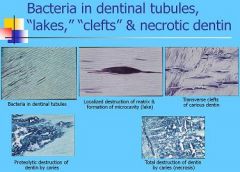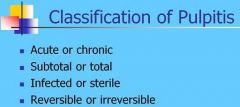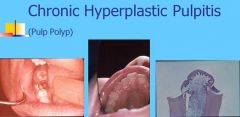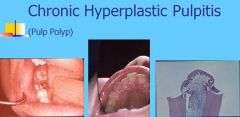![]()
![]()
![]()
Use LEFT and RIGHT arrow keys to navigate between flashcards;
Use UP and DOWN arrow keys to flip the card;
H to show hint;
A reads text to speech;
25 Cards in this Set
- Front
- Back
|
What are three types of pulpal calcifications?
|
Denticles
Pulp Stones Diffuse Linear Calcifications |
|
|
What pulpal calcification are epithelial remanants though to induce odontoblastic differentiation (epitheliomesenchymal interaction)?
|
Denticles
|
|
|
What pulpal calcifications have fine, fibrillar, irregular calcifications that parallel pulp vasculature; increases with age?
|
Diffuse linear calcifications
|
|
|
What conditions can pulpal calcifications be affiliated with?
|
1. Dentin dysplasia II
2. Pulp dysplasia 3. Tumoral calcinosis 4. Calcinosis universalis 5. Ehler-Danlos syndromes |
|
|
What is the rate of destruction dependent on in dental caries?
|
1. Local structural ability to resist destructive forces
2. Ability of systemic defenses and immunologic factors to cope with infection 3. Virulence of the etiologic microorganisms |
|
|
What are the clinical stages of enamel caries?
|
1. Translucent
2. Dark zone preceded by translucent zone 3. Body of the lesion (enlargement of lesion) 4. White spot (reaches DEJ) 5. Chalky (can be scratched by explorer) 6. Cavitation |
|
|
When caries reach the DEJ how do they travel through dentin?
|
Advancing front spreads laterally
Progresses along dentinal tubules toward the pulp in a pyramidal shape with apex toward the pulp. |
|
|
What are the Pathologic Zones of Acute Caries of Dentin?
|
1. Necrotic zone (few if any intact tubules)
2. Infected Dentin (organisms present) 3. Affected Dentin |
|
|
What are the zones within the affected zone?
|
1. Demineralized dentin zone
2. Sclerotic zone 3. Reparative dentin zone |
|
|
In caries of cementum what determines the shape of the lesion?
|
Shape of lesion follows gingival contour
|
|
|
What are some landmarks caused by bacteria in dentinal tubules?
|

Lakes, Clefts, & Necrotic Dentin
|
|
|
How do arrested caries in dentin present?
|
Deeply pigmented (brown), leathery or hard and polished
Necrotic & Infected zones Absent |
|
|
Which zone of acute caries in dentin has
1. Deep portion of demineralized dentin zone (few organisms and intact tubules) 2. Hypermineralized zone (precipitated crystals) 3. Sclerotic layer 4. Reparative dentin layer (protective response to toxic products) |
Affected Dentin
|
|
|
Which pathologic zone of acute caries of dentin has
1. Superficial portion of demineralized dentin zone (tubules intact but distorted) |
Infected Dentin
|
|
|
How does the caries lesion progress in the enamel?
|
Pyramidal shape with apex towards the DEJ
|
|
|
What is inflammation of the pulp from any cause?
|
Pulpitis
|
|
|
How does pulpitis cause necrosis of the pulp?
|
The rigid dentin walls confines inflammation
Inflammation leads to increased intrapulpal pressure and secondary compression of venous return Strangulation of the arterial inflow can lead to necrosis of the pulp |
|
|
What can cause pulpitis?
|

see above
|
|
|
What is the classification of pulpitis?
|

see above
|
|
|
What is an uncommon form of pulpitis in which an inflammatory hyperplasia (granulation tissue) extrudes to fill a large cavity in the crown?
|

Chronic Hyperplastic Pulpitis
|
|

Who and where is Chronic Hyperplastic Pulpitis likely to affect?
|
Children
Mandibular Molars Apex of affected permanent tooth often incompletely formed |
|
|
What is calcific metamorphosis?
|
Secondary reparative dentin leading to accelerated early pulp obliteration (yellow crown)
|
|
|
What is the organization of secondary reparative dentin?
|
Haphazardly organized
Irregular or disorganized tubules |
|
|
What is the organization of physiologic secondary dentin?
|
Has a regular organized structure
|
|
|
What lab test is helpful in diagnosing Desquamative gingivitis?
|
Immunofluorescence
|

